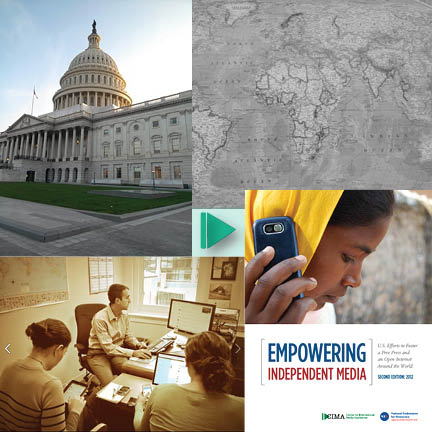With the start of a new year, we at the Center for International Media Assistance are taking stock of our strategy and programs and planning some changes in the way we do business.
CIMA, which was started almost a decade ago to provide a platform for research, knowledge exchange and coordination of international media development efforts, finds itself facing a new set of challenges as the international media undergoes a wrenching process of change. Just like the media sector in developed countries—where newspapers and other traditional media are being replaced by digital formats and a less institutionalized structure—media in the developing world is also undergoing profound changes both in format and business models. At the same time, more people have more access to more types of media than ever before, and the media can be seen to be having increased influence on the course of events. It is a moment of challenges and perils, to be sure, but also one of enormous opportunity.
CIMA’s Mission (Excerpted from 2004 founding legislation): to collect and share information on international media development; improve research to inform decisions on funding and program design; encourage the involvement of the private sector in the field of media assistance; identify effective methods for independent media development in transitional societies
Since I started as Senior Director of CIMA two months ago, we have consulted with our key stakeholders and taken a look at the evolving demands of the media development community. Over the coming weeks, we plan to give CIMA a bit of a facelift. We want to give a boost to its aging website. We will start a series of shorter, more targeted reports, commentaries and short-format essays. And then there’s this new blog, which we hope will become a forum for a variety of people to discuss the many challenges of media development.
In a future post, I will talk in more detail about the challenges that are facing the media development community and some of the substantive issues that CIMA will focus on in the coming months. But for today, I want to concentrate on how we plan to organize ourselves to deliver.
My task is made much easier by the excellent foundation laid by former Senior Director Marguerite Sullivan, who led CIMA from 2006 until 2013. Because of Marguerite and the excellent team she assembled, CIMA is recognized as a critical forum for the media development community, both the funders and the implementers of programs. CIMA also provides important “knowledge resources” to the academic community, both to scholars in academic programs as well as aspiring journalists and other media professionals in J-Schools around the world. CIMA publications — there have been 86 of them since 2006 — are also used by country-level practitioners, such as Mustapha Khalfi, the Moroccan Minister of Communication, who noted during a recent visit to Washington that his office was using CIMA documents as a resource for the country’s media policy reforms.
To revise our website, we are looking at the data of what is being used and downloaded from CIMA’s current website. One thing is already clear: Our reports — often important and unique reviews of critical issues — are not reaching their full potential audience. We want to move away from so many PDF-formatted documents towards searchable Web formats. We also want to use more visual ways of displaying important conclusions of our authors, to help readers quickly find the kind of information they are seeking. We hope to launch the new website by early spring. We want to continue to use such data as a way of tracking how we are doing.
We also want to broaden our audience base to include more people in the international development community. One of the consistent weaknesses found in evaluations of media development work is that it is often isolated from everything else that is going on in developing countries. Media development needs to leverage the work that is going on in other sectors, such as public sector reform, judicial reform, and improvement of the business climate. CIMA wants to reach out to practitioners and professionals in these and other sectors to see what we can learn from them, how they can help us, and how we can contribute to their work.
It’s a big agenda, and an important one. Watch this space for more updates on how this process is going. My look at the substantive issues that we plan to follow will come in my next post.


Comments (0)